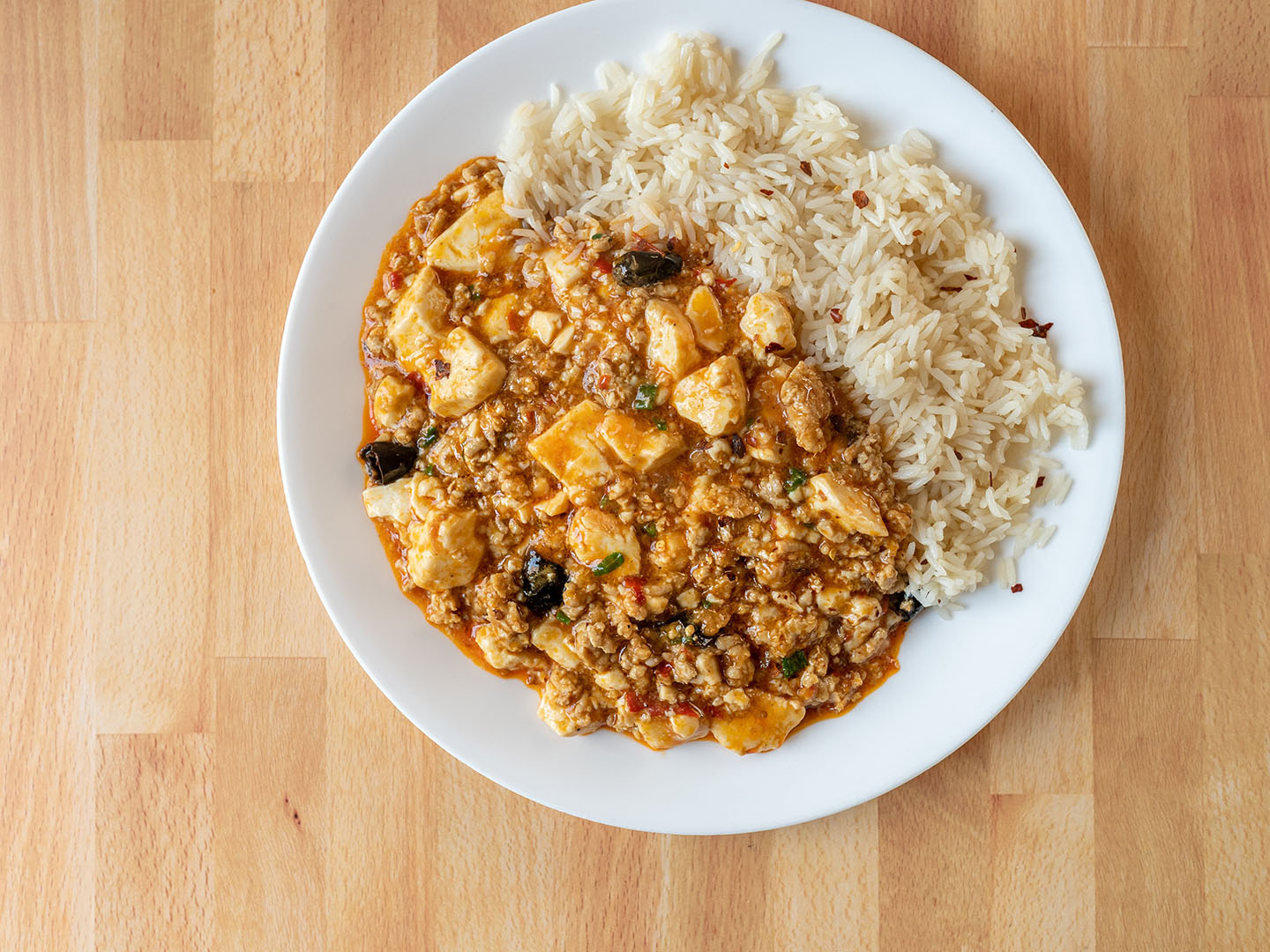Mapo tofu has to be one of my most beloved dishes, an unruly riot on the senses. Unlike most recipe sites on the web, I’ll spare you the Tolkien-scale backstory. Let just dig right into the ingredients and instructions. After that, some notes on the ingredients follow.
Mapo tofu

Ingredients
- 6 dried red chilis
- 4 tablespoons cooking oil
- 1 tablespoon Sichuan peppercorns, ground to a powder
- 3 tablespoons minced ginger
- 3 tablespoons minced garlic
- Half a pound ground pork (or vegan sub)
- 2 tablespoons spicy bean paste
- 1 cup stock (chicken or veggie)
- One package silken tofu, cubed
- 1/2 tsp sugar
- 1 green onion
Instructions
- Roughly chop chillis and heat gently in oil. Don't cook to high or the chilis will burn and turn bitter
- Add ground sichuan peppercorns, cook for 30 seconds.
- Add ginger and garlic, cook for another minute
- Add pork (or vegan sub) and fry with seaosnings until cooked
- Spoon in the spicy bean paste with one cup stock
- Add flour/water slurry, sturring sauce until it thickens
- When happy with consistency bring the heat down to a simmer
- Add cjhoped tofu and cook for five miunutes, don't cook to hard or the tofy will break down
- Finish with chopped green onions
The above recipe is my own version cobbled together from from a variety of online recipes, not least with copious amounts of inspiration from the downright fabulous Woks Of Life – as reliable as any recipe site as I’ve found. Definitely check those guys out if you’re looking for a recipe site that nails it every time.
Mapo tofu – what you need to know
Sichuan peppercorns
This is the cornerstone of the dish, and indeed much of Sichuan cooking, don’t even start without these. There is no substitute. None. Ever tried mapo tofu at a restaurant and left bored? Yup, no Sichuan peppercorns. You can buy them in Asian markets locally and online at Amazon.
I prefer to get all my spices from The Spice House in Chicago (affiliate link, I get a referral fee) – the quality is unsurpassed – and if you buy a good amount of spices – cheaper than most local stores. Their product is game changing: freshly ground, the spice jars explode with aromatics when unsealed. I find product in local stores can be hit or miss, sat as it is for months untouched, unloved, and fried under punishing light.
If you didn’t know, Sichuan peppercorns aren’t actually peppercorns at all, but berries from the prickly ash. They come in a few versions, but you’ll want to seek out the red-hued seed looking guys, not the green ones. Hopefully when you open your container, you’ll be enveloped in their vibrantly unique aroma. You’ll also want a mortar and pestle to grind them to a powder for use.
Spicy bean paste

Another deal breaker. Spicy bean paste, or la doubanjiang, to give it the correct name is wonderful life changing stuff; roughly comprising fava beans, chilis and fermented soy beans. Equally adept as a condiment or cooking tool, the fire engine red paste adds complexity and fire to anything it’s deployed to support. Again, it’s easily purchased online or at local Chinese markets. Do be aware there is a sweet version of this, keep your eyes peeled for the red, savory version.
Garlic and ginger
Go big or go home when it comes to these. If you find a recipe with a meek amount of ginger and garlic, they’re just playing around. Mapo tofu leaves your mouth and tongue a sizzling, scorched , electrified landscape. That comes from the complex interplay of ginger and garlic and chills tempered with Sichuan numb. Go big.
If you’re in a rush go ahead and use the pre-minced stuff in those squeeze jars. If you have the extra ten minutes grab the raw ingredients and reach for the microplane (affiliate link, I get a small fee). The extra effort is worth the materially improved final product.
Chilis

This is one area where I think you can play around. Heresy to a diehards perhaps – as brow searing heat is a trademark of Sichuan dishes; but hey, if you need to build your tolerance, you can start slowly here. Mind you, the best dishes are a balance of capsaicin and peppercorn superconductivity. Throwing one out of whack can upset that balance. If you ratchet down the chilis perhaps slacken up on the other items too. Too much Sichuan peppercorn not correctly balanced can deliver a metallic effect on the palate.
In this recipe you’ll want to use dried red chilis. The sky is the limit here, I usually use six or so. Some recipes call for them to be cooked in oil, that is set aside and added back at the very end – as a piece de resistance – but I simply use them to season the oil at the start of the dish and work ingredients in from there.
Silken tofu
You’re probably familiar with the firm and extra firm varieties of soybean curd – but the custard-smooth silken version is a whole other ball game. Unlike the aforementioned versions, you will need to handle this with kid gloves. You don’t need to dry it before use, simply drain the packet and carefully plop the jellyfish-wobble down on a chopping board. Delicately chop it into cubes. The contrast of softer tofu with pork chew is a signature of mapo tofu.
MSG

One of the most polarizing ingredients in the United States; not least one primed to cause ignorant lazy racism, “oh I don’t eat MSG, it makes me feel funny”. Said commenter proceeds to dig happily into a Chick-fil-A sandwich, which is replete with what exactly now? Yep you guessed it.
MSG is rife in a myriad of the products we eat and it’s magical. The fact that the supposed side effects of monosodium glutamate are assigned almost exclusively to Chinese cuisine, is food racism at it’s finest. If you’re still not convinced you can skip this seasoning (added right at the end, and relatively sparingly) but you’re missing out. You’re also still consuming it on a daily basis without realizing it in chips, soups, condiments, frozen food, fast food and much more.
Kitchen essentials
Lastly, you might want to have a look at our concise list of essentials for any home chef. These are all products I personally use and recommend in a heartbeat. Don’t worry, the list is small, I hate clutter too.
How to make mapo tofu vegan or vegetarian

The last half decade has seen a revolution in the plant based space. The two most significant newcomers – Impossible Foods and Beyond Meat have radically transformed what it means to choose a meat free dish.
To create a vegan friendly mapo tofu I prefer Impossible Foods – and their ground beef product. It comes in one pound bricks, frozen and fresh. If you buy it frozen just leave it in the fridge over night to defrost. From there, you can follow the regular recipe above, just use the Impossible in place of the pork, about a half packet is plenty.
You’ll get the chew and bite of pork, and not too much additional flavor from the Impossible Meat in my opinion – which is quickly blanketed in all that lovely Sichuan flavor. It does add a little additional thickness to the dish in my experience, so perhaps temper your use of cornstarch/water.

Hi, I’m Stuart, nice to meet you! I’m the founder, writer and wrangler at Gastronomic SLC. I’m a multiple-award winning journalist and have written in myopic detail about the Salt Lake City dining scene for the better part of seventeen years.
I’ve worked extensively with multiple local publications from Visit Salt Lake to Salt Lake Magazine, not least helped to consult on national TV. Pause those credits, yep, that’s me! I’m also a former restaurant critic of more than five years, working for the Salt Lake Tribune. I’m largely fueled by a critical obsession with rice, alliteration and the use of big words I don’t understand. What they’re saying about me: “Not inaccurate”, “I thought he was older”, “I don’t share his feelings”.
Want to know more? This is why I am the way I am.
This article may contain content provided by one of our paid partners. These are some of the best businesses in Utah. For a list of all our current and past relationships see our partnership history page.
